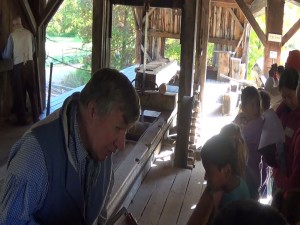Posted by kavery508 | Posted in Uncategorized | Posted on September 25, 2017
 We still need 2 chaperones for our trip on October 13th. Please consider joining us if you can! The time commitment is 8:25-2:45.
We still need 2 chaperones for our trip on October 13th. Please consider joining us if you can! The time commitment is 8:25-2:45.
 This week, there are several new things I want to communicate about homework and papers coming home:
This week, there are several new things I want to communicate about homework and papers coming home:
Math Tests: Our Chapter 1 math test will come home with a “B-A-N” document attached. This paper lets you know which test questions were at basic and applied levels, reflecting a student’s mastery of what was taught, and at the novel level, where students were challenged to try working through a high-level problem. Mastery/perfect score is not expected for novel problems. You’ll likely notice corrections made on your child’s test in colored pencil. We went over the problems after the test, and asked students to find and fix their errors, then set a goal for next test.
Writing: Weekly writing pieces will most often come home with two scores: Focus, and English/Conventions. The numbers correspond to report card ratings (3=Proficient, 2=Making Progress). Focus refers to the students use of organization, detail, length of sentences, and clarity of thought, while Conventions refers to spaces, spelling, endmarks, and correct upper/lowercases. It’s not unusual to see “2s” at first. We’ll be targeting those skills in small group work and 1:1 writing sessions.
Field Trip: We still need 2-3 chaperones for our trip on October 14th. Please consider joining us if you can! The time commitment is 8:25-2:45.
Math Homework Starts This Week: The district’s recommendation is 20 minutes in grade 2, exclusive of reading. Since students work at different speeds, if you find your child has worked diligently but is hitting a frustration level when time is up, you can stop there and jot a note on the page.
Every night, your child should bring home a yellow “Math Homework Resources” folder, in addition to the green communication folder. In the front pocket will be a stapled packet with all 4 nightly assignments. The pages are pre-dated and sometimes they will be double-sided. Students should complete each night’s work; put the packet back in the front pocket; and return the folder the next day along with the green folder. Each morning, I will check the homework and students will return the packets to the folder.
In addition to the packet, there will be 2 optional homework pages sent home each week, marked “Optional Challenge” at the top. They will be placed in the back pocket of the math homework folder. They are great for kids who are ready to think more deeply and broadly about the math concepts we’re working on, and who finish other homework early–but they’re great for everyone else, too! In any case, these pages are not required work; as such, they can be returned any day of the week or not at all.
The pages in the center of the homework folder are there for several reasons. There are vocabulary pages that remind students of the math terms taught in class that they are expected to know (and that show up on homework and tests). You’ll also see sample pages copied from our math book that show how concepts are being taught, and what the homework is looking for students to do. You will also find pictures of base-10 blocks. These can be cut out and kept at home to help when students are stuck understanding and computing with 3-digit numbers, and any time the numbers involved prove too challenging to do it all mentally. I will add to the pages periodically throughout the year.
Regarding how much help to give your child: Please DO help read directions if s/he needs it. Then ask how s/he thinks they should go about solving items. Remind them about using resources in the folder when writing words, etc., and by all means help them if they’re stuck or need a hand getting started. Please DON’T write answers for your child.
The first two nights of homework introduces students to strategies for mental addition. Since this approach is new to most of us grownups, I’ve made a video demonstrating them:
For additional fun practice, students can use the Greg Tang game Break Apart (see link under “Student Resources” above). Select “Addition”; choose which strategy; and click “easy” or “hard”.
And remember, you can access our student Math eBook anytime via your page in Powerschool! This is Chapter 2, lessons 1 and 2. As always, hit me with any questions! <“)

